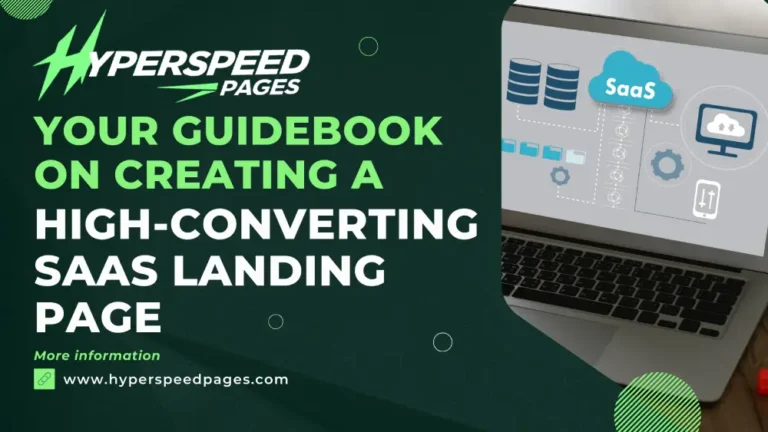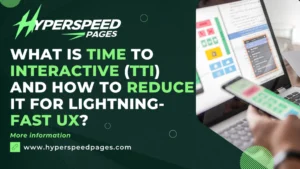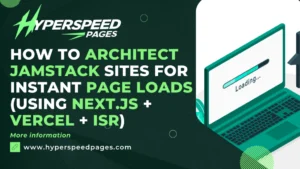
The reason for creating a high-converting SaaS landing page is to convert traffic into customers, showcasing your unique value proposition, and to drive meaningful engagement with potential users. This guide covers the fundamentals of designing a SaaS landing page that not only converts but also builds trust, demonstrates expertise, and encourages interaction.
What’s a Landing Page to SaaS
For SaaS companies, a landing page is often the first interaction potential customers have with your brand. SaaS landing pages are designed to capture attention, establish trust, and drive conversions, typically through signing up, requesting a demo, or subscribing to a newsletter. Well-optimized landing pages help by:
- Improving User Engagement: By focusing on a single call to action (CTA), you help users make decisions faster.
- Reducing Bounce Rates: Clear, compelling content can hold attention and reduce the chances of users leaving the page.
- Boosting Conversions: An effective landing page showcases the product’s value and makes it easy for users to take the next step.
With these goals, let’s further look at the key elements that make a high-converting SaaS landing page.
Critical Elements of a High-Converting SaaS Landing Page
1. Compelling Headline
Your headline is the first thing visitors will see, so it must communicate the core value proposition in a single, impactful statement. Effective headlines are often:
- Clear and Direct: Leave no room for ambiguity. State what your SaaS product does and the primary benefit it offers.
- Value-Oriented: Focus on the specific problem your SaaS product solves and how it benefits the user.
- Attention-Grabbing: Keep it short but powerful. Use keywords to improve SEO, and make it resonate with the target audience.
- Example: If your SaaS product is a project management tool, a headline like “Streamline Your Team’s Workflow and Boost Productivity” clearly states what it does and the main benefit.
2. Concise Subheadline
The subheadline should support the main headline by providing additional context or information. This can expand on the product’s benefits or unique features that make it stand out. Keep it short and to the point, focusing on clarity and relevance.
3. Hero Section with a CTA
The hero section is the “above the fold” area of your landing page where your headline, subheadline, and CTA appear. This is the critical area where you need to hook the visitor within seconds. Include:
- High-Quality Visuals: Use imagery or graphics that reflect your product or its benefits. For SaaS products, this often means screenshots of the interface or interactive elements.
- Primary CTA Button: Have a clear, contrasting CTA button with action-oriented language. Options like “Get Started”, “Start Your Free Trial” or “Request a Demo” work well.
Tip: Use contrasting colors for the CTA to make it stand out, and use descriptive action text to reduce uncertainty and increase clicks.
4. Benefits Over Features
While it’s essential to mention features, focusing too much on them can distract users from the actual value of your product. Instead, highlight how these features translate into benefits for users.
- Bullet Points: Break down benefits into bullet points for easy readability.
- Benefit-Focused Language: Use language that emphasizes the positive impact on the user, such as “Save time with automated workflows”, rather than just listing “Automated workflows”.
5. Clear and User-Friendly Navigation
A SaaS lan5ding page should keep navigation simple to reduce distractions and funnel users toward the CTA. Often, limiting links in the header or footer helps focus the user’s attention solely on conversion.
6. Social Proof and Testimonials
Showcasing trust elements like customer testimonials, reviews, case studies, or logos of well-known clients can significantly increase conversions by building trust. Types of social proof to consider:
- Customer Testimonials: Real quotes from satisfied users that highlight specific benefits they experienced with your SaaS product.
- Case Studies: A deeper look into how your product solved a specific problem for a client.
- Logos of Well-Known Brands: If notable companies use your product, display their logos to convey credibility.
Example: Include a rotating slider of customer testimonials, accompanied by their company logos and titles for added authenticity.
7. Highlight Key Features with Visuals
Use icons, screenshots, or GIFs to visually illustrate key features of your product. These visuals should give visitors a glimpse of what the product does and how it works, enhancing their understanding and interest.
- Screenshots of the Interface: Displaying real screenshots can show potential users what they’ll be working with.
- Interactive Elements: For complex features, consider using GIFs or explainer videos to demonstrate functionality.
Pro Tip: Visual elements should be optimized for both desktop and mobile to maintain a seamless experience.
8. CTA Buttons Throughout the Page
While the main CTA should be in the hero section, repeating CTA buttons throughout the page, especially after key information sections, can improve conversion rates. Each button should lead to the same action, reinforcing a clear path for the user.
Placement Suggestions:
- Below the benefits section
- After testimonials or social proof
- Near the end of the page
9. Product Demo or Explainer Video
For SaaS products, a video demo is highly effective for engaging users and explaining complex functionalities. A short, high-quality video allows users to experience the product without needing to interact directly.
- Keep It Brief: Aim for a length of 1-2 minutes.
- Focus on Value: Rather than showing all the features, focus on the core benefits.
- Use Closed Captions: Many users may watch without sound, so adding captions improves accessibility.
10. Frictionless Form Design
If your CTA involves form submission (such as signing up or requesting a demo), ensure the form is quick and straightforward. Limit the fields to essential information only, and use inline validation to improve the user experience.
- Keep Fields to a Minimum: Fewer fields reduce abandonment rates.
- Offer Single Sign-On (SSO) Options: Allow users to sign up using existing accounts (like Google or LinkedIn).
- Mobile Optimization: Forms should be easy to complete on mobile devices, so use large, clickable buttons.
11. Address Pain Points with FAQs
An FAQ section can alleviate any lingering doubts or concerns that potential customers may have. Address common questions about pricing, features, integration, and support options.
- Organize for Readability: Arrange questions by category or use an accordion design.
- Address Objections: Focus on questions that relate to potential objections, like “What if I’m not satisfied with the product?” or “How secure is my data?”
Designing for Conversion: Key Principles
Adding to the above elements, here are core design principles for a high-converting SaaS landing page:
– Minimalism and Focus
Limit distractions and keep the layout clean and organized. Minimalism helps users focus on the CTA and reduces cognitive load.
– Consistent Branding
Use consistent colors, typography, and messaging across the page. Branding helps establish trust and enhances memorability.
– Mobile Responsiveness
With a high percentage of users browsing on mobile, ensure that your landing page is optimized for various devices, screen sizes, and orientations.
– Load Speed Optimization
A slow-loading page can lead to high bounce rates, so keep load times below three seconds. Optimize images, use lazy loading, and reduce the number of scripts to boost speed.
SEO Best Practices for SaaS Landing Pages
To maximize the organic reach of your landing page, integrate SEO practices that align with Google’s E-E-A-T (Experience, Expertise, Authoritativeness, and Trustworthiness) guidelines.
On-Page Optimization
- Meta Title and Description: Use keywords in the title and description to improve searchability.
- Header Tags: Use H1 for the main headline and H2s and H3s for subheadings.
- Keywords: Target keywords relevant to your SaaS product, and include them naturally throughout the content.
- Image Alt Text: Optimize all images with descriptive alt text.
Off-Page SEO
Build credibility and authority with backlinks from reputable sites. You can also use social media, blog posts, and influencer marketing to drive traffic to your landing page.
Trust Signals
Highlight any certifications, awards, or recognitions your company has received, and make sure your contact information is easy to find.
Advanced Technical Optimizations for High-Converting SaaS Landing Pages
To drive conversions effectively, technical optimizations play a critical role in ensuring that your landing page is both user-friendly and high-performing.
1. Advanced Page Load Speed Optimization
Page load speed is one of the most important factors in retaining users on your SaaS landing page. A faster page keeps visitors engaged and reduces bounce rates, directly impacting conversions.
Strategies for Optimizing Load Speed
- Minify CSS, JavaScript, and HTML: Removing unnecessary characters, whitespace, and comments reduces file sizes, leading to quicker loading.
- Leverage Browser Caching: Configure caching to store frequently accessed resources (like logos and fonts) locally in the user’s browser.
- Use a Content Delivery Network (CDN): CDNs reduce latency by serving content from a network of servers closest to the user’s location.
- Lazy Loading: For images and videos below the fold, enable lazy loading so that these elements only load when they come into view. This decreases the initial page load time.
- Optimize Image Sizes: Compress images using tools like TinyPNG or JPEGmini and use responsive images with the srcset attribute to serve different sizes based on device requirements.
- Limit Third-Party Scripts: Each third-party script (like analytics, tracking, or widgets) adds load time, so use them sparingly and consider asynchronous loading where possible.
2. Schema Markup for Enhanced SEO
Adding structured data through schema markup is a highly effective way to improve the visibility of your landing page in search engines. Schema markup is particularly helpful in getting rich snippets, which can increase click-through rates and provide users with essential information directly in search results.
Schema Types to Consider for SaaS Landing Pages
- Product Schema: Describe your SaaS product, including features, price, and ratings if available.
- FAQ Schema: If your page includes an FAQ section, use FAQ schema to make it eligible for rich results in Google Search.
- Review Schema: Showcase user reviews or ratings to help establish trust.
- Breadcrumb Schema: Breadcrumbs improve site navigation and allow search engines to understand the page structure, which can positively impact ranking.
- Implementation Tip: Use Google’s Structured Data Markup Helper or directly add schema JSON-LD in the HTML header for each structured data type.
3. Analytics and Conversion Tracking
Tracking user behavior on your landing page is crucial for understanding what works and what doesn’t. Implementing analytics tools and setting up conversion goals will allow you to gather actionable insights.
Key Analytics Integrations
- Google Analytics 4 (GA4): Set up custom events and goals to track specific user actions, such as CTA clicks, form submissions, or video interactions.
- Hotjar or Crazy Egg: These tools provide heat maps and session recordings, helping you analyze user interaction patterns and identify areas of improvement.
- Conversion Tracking with Facebook Pixel or Google Ads: If you run paid campaigns, these pixels will allow you to retarget users who visited the page but didn’t convert.
Pro Tip: Use UTM parameters on external links (social media posts, emails, ads) that drive traffic to your landing page. UTM tracking in GA4 will provide granular insights into the performance of each traffic source.
4. Personalization with Dynamic Content
Personalization can significantly increase conversions by providing a customized experience based on user attributes such as location, previous interactions, or referral source.
Techniques for Personalizing SaaS Landing Pages
- Dynamic Text Replacement (DTR): Adjust your page’s text based on keyword search or ad campaign targeting to match user intent closely.
- Geolocation-Based Personalization: Show different content, offers, or CTAs based on the user’s location to make the experience more relevant.
- Referrer-based Personalization: Customize content based on the traffic source (like an ad, social media, or email campaign). For example, if a user clicks on an ad targeting “productivity tools for remote teams”, display specific messaging about remote collaboration features.
- Behavioral Personalization: Use cookies to remember a returning user’s preferences or actions (such as signing up for a newsletter) and display personalized content accordingly.
Implementation Tip: Many SaaS tools, like Optimizely and Unbounce, offer personalization options or can be integrated with personalization platforms to simplify this process.
5. A/B Testing for Continuous Optimization
A/B testing allows you to test different variations of landing page elements to determine what resonates best with your audience. You can run experiments on various page elements like the CTA, headlines, colors, images, or layout to maximize conversions.
A/B Testing Best Practices
- Test One Element at a Time: Isolate one variable (such as CTA text or button color) to understand its impact without other influencing factors.
- Use a Large Enough Sample Size: Ensure that each version receives adequate traffic to produce statistically significant results.
- Analyze Results Over Time: Allow tests to run for a sufficient period to account for variability across different days and user behaviors.
- Automate Testing with Tools: Tools like Google Optimize, VWO, or Optimizely provide robust A/B testing features and help streamline the process.
Pro Tip: Start by testing the elements with the highest impact on conversion rates, like the main CTA, headline, and hero image. Once you optimize these high-impact areas, you can test secondary elements, like subheadlines or testimonials.
6. Mobile Optimization: AMP and Responsive Design
With mobile traffic often outpacing desktop, mobile optimization is non-negotiable for SaaS landing pages. Responsive design ensures that the page adjusts across various screen sizes, but additional optimizations for mobile can improve load speed and usability.
Mobile-specific Optimization Tactics
- Implement Accelerated Mobile Pages (AMP): AMP reduces load times on mobile devices by serving a simplified version of your page. Although it’s limited in customization, it’s effective for pages targeting mobile users.
- Mobile-Friendly CTA Buttons: Ensure that CTA buttons are large, clickable, and positioned where mobile users can easily reach them (usually at the center or bottom of the screen).
- Simplify Forms for Mobile: Use large input fields, avoid dropdowns where possible, and leverage autofill features for a smoother experience.
- Touch-Friendly Elements: Use padding and spacing to prevent accidental taps on adjacent elements.
7. Security and Privacy Compliance
Security and privacy are essential, especially when collecting user information through forms. Adding trust indicators like SSL certificates, privacy policy links, and compliance badges increases credibility and aligns with Google’s E-E-A-T standards.
Best Practices for Ensuring Security and Privacy Compliance
- SSL Certificates: HTTPS is a standard requirement for secure data transmission. It’s also a ranking factor for Google, so ensure your page is SSL-protected.
- GDPR Compliance: If targeting European users, include opt-in checkboxes for data collection with clear explanations of how the data will be used.
- Trust Seals and Privacy Links: Add recognizable trust seals (e.g., McAfee Secure, Norton Secured) and link to a detailed privacy policy at the footer.
Pro Tip: Display a brief, non-intrusive cookie consent pop-up for first-time users to comply with GDPR requirements.
8. Using Retargeting for Abandoned Conversions
Retargeting allows you to reach users who visited your landing page but didn’t convert. By showing tailored ads on other platforms, you remind them of your offer and encourage them to return.
Effective Retargeting Strategies
- Dynamic Retargeting Ads: Personalize ads based on the user’s actions on the page. For example, if they abandoned a demo signup, retarget with an ad that emphasizes the benefits of the demo.
- Email Retargeting: If users signed up but didn’t complete a desired action, you can send them reminder emails with additional incentives or content to guide them back.
- Frequency Caps: Limit ad frequency to avoid overwhelming users, which can lead to ad fatigue.
Implementation Tip: Use Google Ads, Facebook Ads, or LinkedIn Ads to set up retargeting audiences based on page visitors or those who engaged with specific elements, like video or CTA buttons.
Final Thoughts: Testing and Optimization
Conduct regular A/B testing to refine elements such as headlines, CTA buttons, and layout. Use heat maps and analytics to see how users interact with the page, identify drop-off points, and make data-informed adjustments.
SOURCE:




